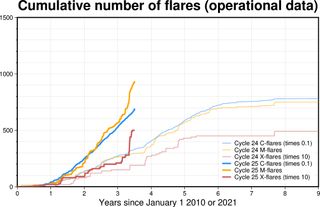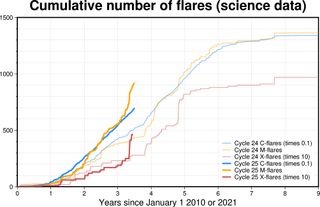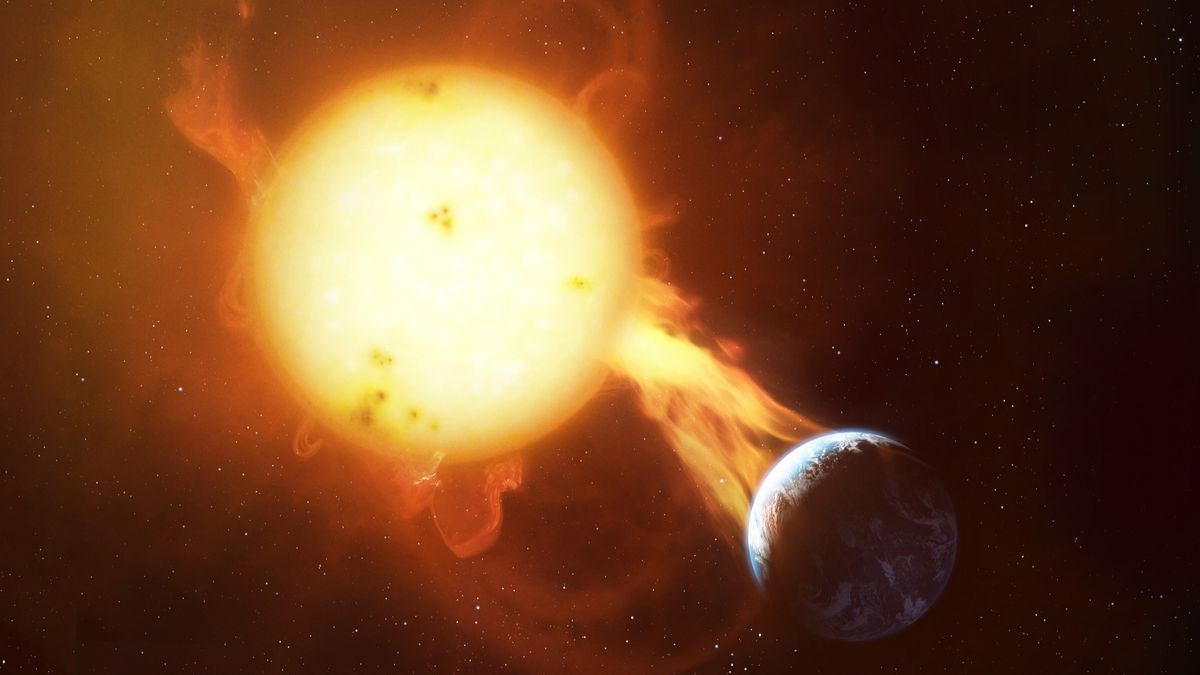Like the number of sunspots, the occurrence of solar flares follows the approximately 11-year solar cycle.
But as the current Solar Cycle 25 approaches its peak, how are the number of solar flares stacking up against the previous, smaller Solar Cycle 24?
Due to a change in flare calibration levels from 2020, you’ll find two answers to this question online — but only one is correct.
Related: The sun’s magnetic field is about to flip. Here’s what to expect.
The sun follows an 11-year solar cycle of increasing and decreasing activity. The solar cycle is typically measured by the number of sunspots visible on the sun, with records dating back over 270 years. Most solar flares originate from sunspots, so with more sunspots — you’ll get more flares.
Solar flares are categorized into flare classes, classified by the magnitude of soft X-rays observed in a narrow wavelength range of 0.1-0.8 nm. The flare classes are C-class, M-class and X-class, each 10 times stronger than the previous. (Flare levels are then sub-divided by a number, e.g. M2, X1, etc). Flares of these categories (except the very largest of the X-class events), tend to follow the solar cycle closely.
In terms of sunspot numbers, Solar Cycle 25 (our current cycle) has exceeded the sunspot levels of Solar Cycle 24 (which peaked in 2014). With higher sunspot numbers, we’d also expect higher flare counts. This is the case, but the difference is far from what some would have you believe.
Recalibrating solar flare levels
How do solar flares compare between Solar Cycles 24 and 25? This seems like a simple enough question, but is muddied by a recalibration of solar flare levels in 2020 from the National Oceanic and Atmospheric Administration (NOAA).
Solar flare X-ray levels have been measured since 1974. X-rays do not penetrate Earth’s atmosphere, and thus can only be measured by detectors on satellites in Earth orbit. For 50 years, these solar flare detectors have been placed on NOAA’s GOES satellites. As technology improves, and old technology decays, newer detectors are launched on newer GOES satellites, to keep the continuous observation of solar flares going. GOES-18 (the 18th satellite in the sequence) is the current satellite responsible for primary X-ray observations, having launched in 2022.
These flare-defining X-rays are measured by X-ray sensors onboard the NOAA GOES satellites. GOES satellite have been around for decades, and their solar X-Ray detectors are operational for a few years, until a newer replacement is launched. pic.twitter.com/3INrEKPFWFMay 5, 2024
Because flare levels have been measured (and their classes defined) by detectors across multiple satellites/instruments, corrections are sometimes needed to account for slight differences in calibration from one detector to the next.
From 2010-2020, flare levels were defined by measurements from GOES-14 and GOES-15. This period covered the solar maximum period of Solar Cycle 24, up to the end of that cycle. However, upon the launch of these two satellites, a calibration discrepancy was discovered between GOES-14/15 and all prior GOES X-ray detectors. To fix this, science data from 1974-2010 (from GOES-1 to GOES-13 satellites) were all readjusted to match the new calibration, which was believed to be correct at the time. A result of this was that the threshold for each flare class increased by 42%, meaning an individual solar flare in 2010 needed to be 42% larger than a flare from 2009, to be given the same X-class level.
However, and here comes the twist: following the switch to GOES-16 data on a new detector, it was discovered that the original calibration (from 1974-2010) had been correct all along, and the 2010-2020 calibration was the incorrect one. This meant that in 2020, all prior data (from 1974-2020) were again recalibrated to their previous correct levels, lowering back the threshold of different flare classes). With a lower flare threshold, it meant strong C-class flares (C7+) became M-class events, and strong M-class flares (M7+) became X-class flares. An X-class solar flare was therefore far easier to achieve in 2021 than it was in 2019. This 2020 recalibration therefore increased the number of higher classes flares in Solar Cycle 24 than initially reported.
A discrepancy in flare numbers
Following the 2020 recalibration of solar flare levels, NOAA re-released their historic scientific flare datasets with the correct levels. However, the archived operations data, which lists solar flare levels as they were initially reported at the time, were not recalibrated. A consequence of this is that different flare lists compiled and analyzed by third parties, can either use the recalibrated science data, or un-recalibrated operations data when comparing solar flare levels between solar cycles. The former comparison yields correct results, while the latter compares current flare levels from cycle 25 with severely underestimated flare levels from previous cycles, producing scientifically incorrect comparisons. Let’s compare some data!
Comparing Solar Cycle 24 and Solar Cycle 25
The graphs below show the number of solar flares occurring within each flare class, in a comparison between Solar Cycles 24 and 25. The blue, orange and red lines show the number of C, M and X-class flares respectively, multiplied by 0.1, 1 and 10 to plot the data on the same axis.
The thicker lines show this data for Solar Cycle 25 (with years since 2021 on the X-axis). The thinner, less saturated lines show the same data for Solar Cycle 24 (plotted against years since 2010).
This first plot shows this comparison from historic flare operation data, i.e. not taking the 2020 recalibration into account.

This graph shows a massive difference in flare levels from cycles 24 to 25. According to this plot, the total number of M and X-class flares in Cycle 25 has already overtaken the total flare numbers from Cycle 24, in less than half the time. This is a punchy headline and was posted by several prominent social media accounts. But as punchy as that statistic sounds, it is incorrect. As we have discussed, this plot does not account for the 42% recalibration of flare levels.
This second plot shows the same comparison, this time from the accurate science data.

This graph shows the correct comparison of solar flares between Cycles 24 and 25. As you can see, although the number of Cycle 25 flares is still ahead of Cycle 24 at each flare level, the discrepancy is far less than that shown in the previous graph. The operations data undercounts the number of Cycle 24 flares by nearly half, a significant difference. In reality, the number of X-class solar flares in Cycle 24 is only half the total Cycle 24 quantity and even had fewer X-class flares until the recent solar activity from famous active regions AR 13663 and AR 13664. This graph also shows that although May 2024 saw a lot of X-class activity from these active regions, this level of activity is not unprecedented — with Solar Cycle 24 experiencing a similar leap in flares towards the end of 2015.
So remember, if you see the comparison of Solar Cycle flare levels online, be sure to check if they’re using the historic operations data (incorrect), or recalibrated science data (correct).











/https://tf-cmsv2-smithsonianmag-media.s3.amazonaws.com/filer_public/34/31/3431771d-41e2-4f97-aed2-c5f1df5295da/gettyimages-1441066266_web.jpg)







Discussion about this post